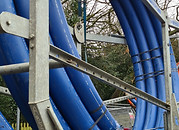Why use Horizontal Directional Drilling?

Why use Horizontal Directional Drilling?
Horizontal directional drilling allows for the installation of utilities from one point to another without destroying the existing ground or obstacles that are in between the two points.
HDD goes above and beyond traditional trenching; connecting utilities and services in places that traditional trenching is impossible.
Horizontal Directional Drilling has 5 major advantages...

Durability
The materials used during the HDD process are notoriously tough with a long lifespan and the increased accuracy in placement prevents damages during the installation process. In addition to this, in areas which required a watercourse such as a river to be crossed, pipes would traditionally be placed under bridges, exposing them to elements that led to their wear and tear - This significantly reduces their lifespan and routinely results in leaks or bursts in the most inconvenient and dangerous places. By burying the new utility, the HDD process offers the maximum protection to your new utilities.

Productivity
One of the most obvious benefits of the HDD method is a substantially faster installation HDD ensures that the work is generally completed much faster as compared to the traditional method which by design requires the ground to be broken, dug down and then across even before any pipe can begin to be installed. In addition, less dirt and spoil being displaced results in less of it to bury and dispose of.

Lower Costs
Many of our clients have been surprised that the HDD method can be far more financially economical in a well-planned project than would be the case if trenched methods were used; HDD projects happen quickly, so on-site timetables and the costs related to them, traffic management for example, are reduced. Far less plant equipment and operators for them are required as excavation activity is limited. Reinstatement cost, especially for works taking place on highways or footpaths are reduced by huge margins.

Flexibility
HDD allows for placement of pipes and utilities where there are significant obstacles. For instance, if a line is needed under a road, railway or a river, the flexibility of HDD means that locations rendering placement of new utilities expensive, disruptive or even virtually impossible, can now be utilized. The far smaller site footprint of the HDD method also means that HDD operations can be undertaken on sites with limited or restricted access - after all, the only two locations on site that are directly affected by horizontal directional drilling works are at either end of the site - the launch point and reception pit.

Environment
Installation via HDD has the least environmental impact of any construction method. As shown in study carried out in the US (detailed below). As well as producing 3x the CO2 emissions compared to the HDD option, open trench methods emit more than 70% more airborne emissions.
Trenchless vs Traditional ...

A study conducted in the United States was undertaken to determine the real-life comparable data of traditional versus trenchless methods. This included comparing differences in environmental impacts, traffic impacts, and productivity between traditional open-cut construction and HDD portions of several projects involving the replacement of existing asbestos water mains. This study was unique in that it provided a head-to-head comparison of the two methods in the same local
environment over various projects. Field emissions data was collected and inputted into specialist
eCalc software.
The results found the HDD option to have emitted only 23% of airborne emissions compared to open cut. Furthermore, converting emitted emissions to a normalize value found HDD to have produced less than a third of CO2 emissions produced during open-cut works.
As expected, traffic impacts were minimized with the HDD option. The sections with installations using traditional open-cut construction involved closure of the entire street and roads to traffic. Conversely, only half of the street or single road lanes under traffic management were closed during the HDD installations, thus enabling traffic flow.
Overall productivity was much higher with the HDD option. The analysis found HDD achieved an average productivity of 1.91 L.F./minute compared to traditional open-cut, which achieved an average productivity of 0.43 L.F./minute. This translates to HDD achieving productivity greater than four times that of open cut.


